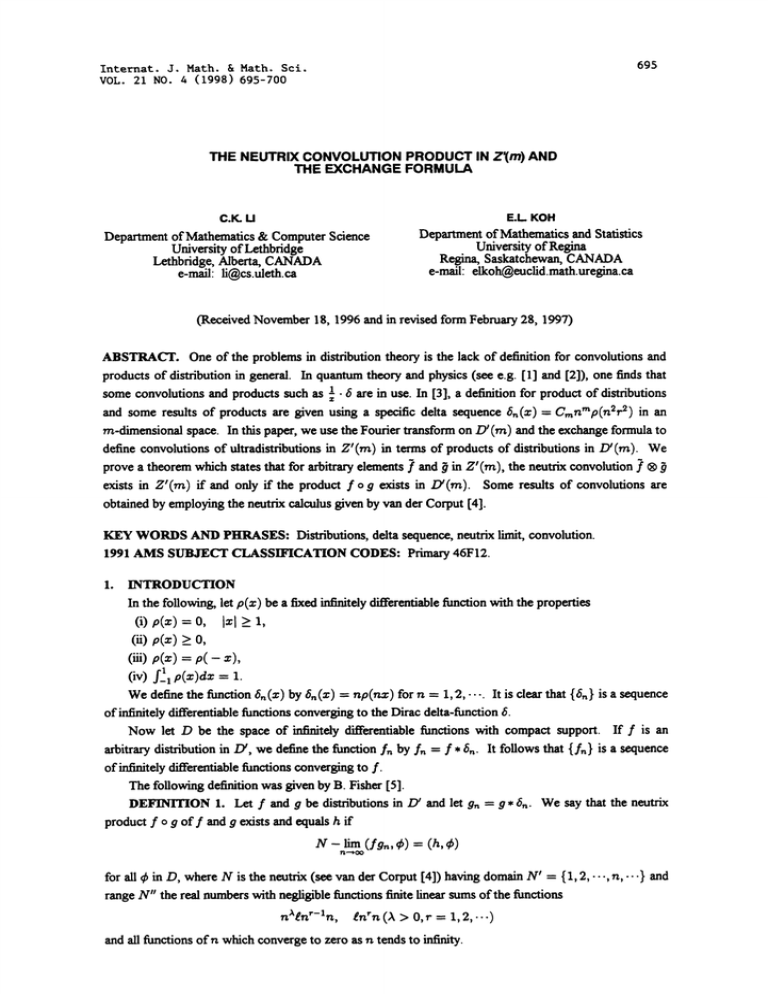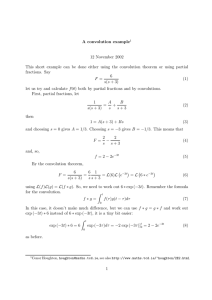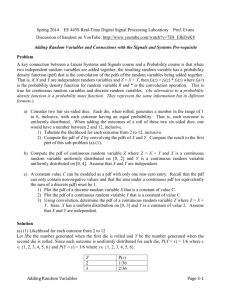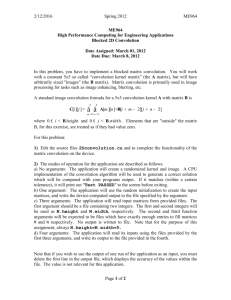Document 10458451
advertisement

695
Internat. J. Math. & Math. Sci.
VOL. 21 NO. 4 (1998) 695-700
THE NEUTRIX CONVOLUTION PRODUCT IN Z(rn) AND
THE EXCHANGE FORMULA
C.K. U
E.L KOH
Department of Mathematics & Computer Science
Department of Mathematics and Statistics
University of Lethbridge
Lethbridge, Alberta, CANADA
e-mail: li@cs.uleth.ca
University of Regina
Regina, Saskatchewan, CANADA
e-mail: elkoheuclid.math.uregina.ca
(Received November $, 1996 and in revised form February 28, 1997)
ABSTRACT. One of the problems in distribution theory is the lack of definition for convolutions and
products of distribution in general. In quantum theory and physics (see e.g. [1] and [2]), one finds that
6 are in use. In [3], a definition for product of distributions
some convolutions and products such as
and some results of products are given using a specific delta sequence 6,(z)= C,,n"’p(n2r2) in an
m-dimensional space. In this paper, we use the Fourier transform on D’ (ra) and the exchange formula to
define convolutions of ultradistributions in Z’(ra) in terms of products of distributions in D’(ra). We
prove a theorem which states that for arbitrary elements and in Z’(m), the neutrix convolution ? (R)
exists in Z’(ra) if and only if the product f o g exists in/Y(m). Some results of convolutions are
obtained by employing the neutrix calculus given by van der Corput [4].
.
.
KEY WORDS AND PHRASES: Distributions, delta sequence, neutrix limit, convolution.
1991 AMS SUBJECT CLASSI1CICATION CODES: Primary 46F12.
1.
INTRODUCTION
In the following, let p(z) be a fixed infinitdy diiferentiable function with the properties
(i) p(x)=O, Ixl>l,
(i) p(=) > o,
(iii) p(x) p(- z),
(iv) fz_ p(z)dx 1.
We define the function 6.(z) by 6.(=:) np(n=) for n 1,2,-... It is clear that {6.} is a sequence
of infinitely differentiable functions converging to the Dirac delta-function 6.
Now let D be the space of infinitely differentiable functions with compact support. If f is an
arbitrary distribution in/, we define the function f. by f. f 6.. It follows that {f.} is a sequence
of infinitely differentiable functions converging to f.
The following definition was given by B. Fisher [5].
DEFINITION 1. Let f and g be distributions in D’ and let g. g. 6.. We say that the neutrix
product f o g of f and g exists and equals h if
N
n (f., ) (, )
for all qb in D, where N is the neutrix (see van der Corput [4]) having domain N’ { 1, 2,..., n,...} and
range N" the real numbers with negligible functions finite linear sums of the functions
nXn"-ln, n"n (A > O, r
1, 2,..-)
and all functions of n which converge to zero as n tends to infinity.
C. IC LI AND E. L. KOH
696
Let D’(m) be the space of distributions defined on the space D(m) of infinitely differentiable
functions of the variable z (zl,z2,..., z,,,) with compact support.
In order to give a definition for the neutrix product f o g of two distributions f and g in LF (m), we
attempt to define a b-sequence in D(m) by putting
,
(z,x2,-..,)
()..-(x=),
where is defined as above. However, this definition is very difficult to use for distributions in D(m)
which are functions of r, where r (z +..-+x2) /2. Therefore an alternative definition was
introduced in [3].
From now on we let p(8) be a fixed infinitely differentiable function defined on R+ [0, oo) having
the properties
(i) (8)=0, s_>l,
Define the function (z), with z
R=, by
()
for r
(ii) (s)_>O.
c(2)
1, 2,---, where C is a constant such that
,(x)dx
1.
DEFINITION 2. Let f and g be distributions in D’(m) and let
where t (tx,t2,-’-,*m). We say that the neutrix product f o g of f and g exists and is equal to h on
the open interval (a, b), where a (a, .--, a,) and b (b,..., b=), if
for all test functions b is D(m) with support contained in the interval (a, b).
2.
FOI.IRIER TRANSFORM ON D’(rn)
As in Oel’fand and Shilov [6], we define the Fourier transform of a function $ in D(m) by
where (:, e) denotes :te +.-. +
The bounded support of $(x) makes it possible for
argument s (sl,.--, 8=) (e + i’1,-.-, ’n +
to be continued to complex values of its
Our new function q(), defined on Cn, in the space of functions of m complex variables, is
continuous and analytic in each of its variable s. If b(x) vanishes for ]xt > at, k 1, .--,m, then
O(s) satisfies the inequality
Conversely, every entire function q(s,-.-, s,) satisfying the above inequality is the Fourier transform of
some $(z,...,z=) in D(m) which vanishes for Ix] > at, k 1,2,
The set of all entire analytic functions Z (m) with the property (1) is in fact the space
...,
F((,))
{,: S e () such that F()
.
CONVOLUTION PRODUCT
697
Convergence in Z(m) is defined via convergence in D(m)" a sequence {V;,} tends to zero in Z(rn)
if the sequence {,} tends to zero in D(rn), where F(4,,)= g,,. The Fourier transform of a
distribution in D’(n) is an ultradistribution in Z’(rn), i.e., a continuous linear functional on Z(rn). It is
defined by Parseval’s equation
.
CONVOLUTION IN Z’(n)
In order to define a convolution product in Z’(rn), we introduce the Fourier transform F(6,) of
(where .() C.(2,2)) and wte
T.(a)
which is a function in Z (m) for
From Parseval’s equation
(7-., .,)
,
F(6.)(a)
1, 2,--.
2r(6., 4’)
.-.o%
2r(6, 4’)= 27r4,(0)
(r)dr
2r
(1,
Therefore {-,} is a sequence in Z(n) C Z’(rn) converging to in Z’(m).
be an arbitrary ultradistribution in Z’(rn). Then there exists a distribution
such that ] F(f). Setting ], F(f 6,) F(f,), we have
Now let
in Z (m).
LEMMA 1. Let
where
function
.
(2., )
2r(f., @)
2r(f, b)
(2, )
n
-,
oo
be an arbitrary ultradistribution in Z’(n) and let
e.(,.,)
f in D’
F(g. 6,). Then the
(.(,:,), V.,(o + ,))
is in Z(m) for all V in Z(m).
Indeed,
e.(u)
(F(g.),F(ee’"@(z))(o))
2(g., e’:’:",(z))
2rF(g.@)(u).
Now the result of the lemma follows on noting that g,,@ is in D(rn).
We now modify the definition for the convolution product of two distributions in D’() given by
Gel’fand and Shilov with
.
.
DEFINITION 3. Let and be ultradistributions in Z’(rn) such that the function (.((), V)(( + u))
is in Z(rn) for all V; in Z(rn). Then the convolution product ] is defined by
.
for all V in Z(m).
It follows that ]
6 Z(rn), then gO 6
.
((], .)(,), v,(,)) (](,,), ((,,), v,(o + ,,)))
exists if gO is in D(,n). (This condition is not always true for aH g e D’ (,n). If
D(rn).) Indeed
(((), V(( + v)) 2r(g, eivO(z)) 2rF(g4,)(v),
where 9 F(g) and V)
The following theorem then holds:
THEOREM 1. Let ] and 9 be ultradistfibutions in Z’(rn) and suppose that the convolution
product ] exists. Then
.
Co K. LI AND E. Lo KOH
698
(2)
(3)
PROOF. If F()
p, we have
Hence Z’ (rn) is closed under differentiation.
Certainly
for all p in Z(m). Equation (2) follows.
From the fact that if F(), we get
+
It follows that
Hence
for all g, in Z (m) d fion (3) follows.
Note at
F(f) is ge.
We now note t if ] d e iu ultra&fibufions Z’(m),
e convolution product
flways s bythe ve dfion (3) m by
1, (.(), ( + )) is in Z(m) for fll
Z (m). s ls us to the foHong dfion.
DEON 4.
d
difibufions in Z’(m) d 1
Th e n
nvolufion pru @ is d to be e n t of the suence
}, prodded the
ntfix t s the
at
’
N
-
. ,..
(
,)
(, )
Defion 4 is d a gefion of Dfion 3,
by Oeon 3, en ((),( +)) Z(m), i.e.,
C=(m).
, ,
for fll
n
in Z(m)
ce ff e convolution pru
(m) for
(m). s
efists
pies
efore ((), ( + )) 2F(gO)() nvges to ((), ( + )) in Z(m). Ts is
bemuse g
(if f C
fO (whe f f 6) converges to f uoy on e ppoa of
0) in D(), d N
( ) ( ) for in Z(m).
e foHog r holds for e nm nvolution produ.
OM 2. L md
ibufiom
Z’(m) md mp t th ntfix
nvolufion produ s. en e n nvolution produ @ efists md
PROOF. We have
and it follows that
,
699
NEI/IP./X CONVOLUTION PRODUCT
for arbitrary p in Z (m). The result of the theorem follows.
Note that ( (R).)’ }" (R)’ iffN
-,limo(’,(r,),
.
.
0 for all in Z(m).
We now prove our main result, the exchange formula.
THEOREM 3. Let and be ultradistributions in Z’ (m). Then the neutfix convolution product
(R) exists in Z’(m) iffthe neutrix product f o g exists in D’(m) and the exchange formula
] @ 9 2rF(f o g)
is then satisfied.
PROOF. Let p
F(b) be an arbitrary function in Z(m) and let
e,(v) (9.(;), g,(< + v)) 2rF(g,b)(v).
Then on using Parseval’s equation we have
(.(u), e,(u)) 27r(](), F(g,b)(v)) (2r)2(fg,, b).
If the ntdx convolution produ
(2) 2 (f o g, )
2(F(/o g), F()).
The neutrix product f o g therefore exists and the exchange formula is satisfied.
Conversely, the existence of the neutrix product f o g implies the existence of the neutrix
convolution product and the exchange formula.
4.
SOME RESULTS
The following Fourier transforms of the functions r x and A kt(x) were given in [6]
where A
rn,
rn
2,.-. and 0
i_o" and
Hence it follows that
where A denotes the Laplace operator.
THEOREM 4. The neutrix convolution products p2k-,, (R) 1 and p2-1-m (R) 1 exist and
p2k-,n (R) 1
r(m.)rm/2-1k!m(m + 2)...(m + 2k
p2k-l-m (R) 1
0
1,2, ..-, [].
PROOF. We have the following neutfix product (see [3]),
for k
2)
C. IC LI AND E. L. KOH
700
r -2.-
6(x)
A*(z)
2*klm(m + 2)-.-(m+2k 2)
r i-- 5(x)
0
By the exchange formula
Thus
2_2,+mTrm/2
p2*-m 1=
2*k!m(m + 2)...(rn + 2k 2)
It follows that
p2*-m (R) 1
-
The second equation follows easily.
The following neutrix product is also given in [3]
r
for ]
1,2,..-,
L] and
A(z)
a+::(z)
2*(k + 1)!(rn + 2).-.(m + 2k)
f.l-2k. A(x)
0
Hence we obtain
THEOREM 5. The neutrix convolution product p2,-m (R) p2 and 2,-1- (R) 2 exist and
p2k-m (R) p2
r()2-+
r (m)vrm/2- (k + 1)[(m + 2)-. -( -Jp2*-l-m (R) p2
0
1,2,...,
ACKNOWLEDGEMENT. This research is partially supported by the University of Lethbddge
Research Fund.
[1] BREMERMANN, J.H., Distributions, Complex Variables, and
[2]
Fourier
Transforms, Addison-
Wesley, Reading, Massachusetts, 1965.
CHEN, Q.Y., A survey of the budding nonlinear theory of distributions (in Chinese), J. ofMath., 1
(1981), 127-133.
[3] LL C.K and FISHER, B., Examples of the neutrix product of distributions on R", Rad. Mat., 6
(1990), no. 1,129-137.
[4] VAN DER CORPUT, J.G., Introduction to the neutrix calculus, J. Analyse Math., 7 (1959-60), 291398.
[5] FISHER, B., On defining the convolution of distributions, Math. Nachr., 106 (1982), 261-269.
[6] GELTAND, I.M. and SHILOV, G.E., Generalized Functions I, Academic Press, New York, 1964.



